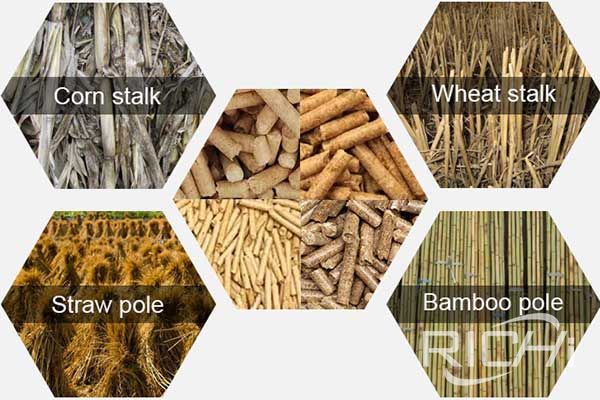
This is where you find all our press releases and news articles.
Whether you plan to buy wood pellets or build a wood pellet factory, it is important to know which wood pellets are good and which are harmful. Due to the development of the industry, there are more than one standard for wood pellets in the market. The standardization of wood pellets is an established and unified specification for industry products. Since the publication of the Austrian Standard (ÖNORMM1735) in 1990, some EU member states have developed their own national particle standards, such as DINplus (Germany), NF (France), Pellet Gold (Italy), etc. As the world's largest pellet market, the European Commission has established an EU solid fuel standard (CEN TC335-EN 14961) based on the Austrian standard (ÖNORMM1735).

How to identify good wood pellets?
1. Wood pellet diameter error: ≤1MM
The most common sawdust particles are 6mm and 8mm in diameter. Generally, the smaller the diameter, the better its particle properties. However, if the diameter is less than 5mm, it will increase energy consumption and reduce capacity. In addition, due to the shape of the particles, the volume of the product is compressed, saving storage space. In addition, it is easy to transport, so the transportation cost is low. In all existing standards, it is generally accepted that the diameter error does not exceed 1 mm.
2. Particle water content: ≤10%
According to all sawdust particle standards, the required moisture content is similar and does not exceed 10%. Technically, in this process, moisture is the binder and lubricant. If the moisture content is too low, the particles cannot be fully stretched, so the particles may deform and have a lower density than normal particles. However, if the moisture content is too high, the energy consumption will increase and the volume will increase. Generally, the surface of the particles will be rough. In severe cases, the raw materials may emerge from the pellet machine mold. All grain standards indicate that the optimal moisture for wood pellets is 8%, and that for cereal biomass grains is 12%. Particle moisture can be measured with a moisture meter.
3. Particle density: ≥600 KG / M3
The density of sawdust particles is one of the most important specifications, which can usually be divided into bulk density and particle density. Bulk density is a characteristic of powdered materials (such as granules) and the formula is the number of powdered materials divided by the required volume. Bulk density affects not only combustion performance, but also transportation and storage costs.
In addition, particle density also affects its bulk density and combustion performance. The higher the density, the longer the continuous burning time.
4. Granular mechanical durability: 96.5%
Mechanical durability is also an important parameter. During transportation and storage, particles with low mechanical durability are easily damaged and increase the powder content. Of all biomass particles, wood pellets maintain the highest mechanical durability, approximately 97.8%. Compared with all biomass particle standards, its mechanical durability is always no less than 95%.
5.Low chemical element content
For all end users, the most interesting issue is emissions, including NOx, Sox, HCl, PCCD (polychlorinated dibenzodioxins) and fly ash. The content of nitrogen and sulfur in the particles determines the content of NOx and Sox. In addition, corrosion problems are determined by the chlorine content. In order to have better combustion performance, all particle standards recommend the use of a lower chemical element content.
Having the right mix of reliable, high-quality pellet machine and pelletizing systems and expert support is essential to your success. Watch how our end-to-end feed pellet plant solutions have helped our customers optimize their performance.
Our customized and future-proofed turnkey pellet plant solutions is designed with you at the core. From vision to reality and beyond, our team stays connected with yours. Giving you peace-of-mind with an expert at your side.

At RICHI, we go beyond project completion. With RICHI Servicee, we’re your dedicated partners in success. Count on us for expert guidance, minimal downtime, and optimized productivity. Choose RICHI for unmatched service and support.



Meet global product demands and quality standards with industry-leading pellet plant design, engineering, equipment, and construction services for pellet processors.


Your Partner Beyond Project Completion
2000+ cases
RICHI is the leading designer, manufacturer and builder of pellet plants in the world, completing over 2000 projects in 140 countries across 6 continents.
Read More
Increase plant productivity, profitability, and safety by integrating high quality equipment into your pellet production line. Over the years, RICHI has become China's top pellet equipment manufacturer. At the same time, RICHI has established valuable partnerships with the world's leading component and raw material manufacturers to bring you the best there is in technology, automation, and efficiency in pelleting plant machinery.

For nearly 30 years, RICHI has been providing best-in-class pellet plant equipment and services to clients across a variety of industries, sizes, and needs. We pride ourselves on the knowledge and skill that each team member possesses – from our technical sales team to our process design engineers. You can count on RICHI Machinery to take your operation to the next level of innovation, quality, and success.
Need help with your pellet manufacturing plant project? Contact us today.
ANIMAL FEED
BIOMASS
WOOD
ORGANIC FERTILIZER
AQUA FEED
CAT LITTER
MUNICIPAL WASTE RECYCLING
SPECIAL PELLET PRODUCTION
RICHI Machinery continues to deliver world class pellet mill equipment, pellet plant engineering and project solutions that add value to our customers in the animal feed, wood waste, agriculture waste, organic fertilizer, cat litter and special pellet products industries. Throughout the years, we RICHI Machinery have built strong brand, becoming industry-leading pellet machine manufacturer. We value integrity, promise quality, and prioritize your success.
Learn MoreWith our expert team, we precisely implement your process engineering requirements in pellet mill and pelletizing plant systems. No matter which industry you’re in – we understand your needs and deliver solutions that meet the highest standards.
At RICHI, quality comes first. Our pellet making machine and related pellet line equipment undergo rigorous quality controls to ensure they meet the highest standards. Rely on products that are durable, safe, and efficient.
With decades of experience in pellet machine and pellet production line production, we have earned a reputation as a trusted partner in various industries. Our expertise allows us to cover a wide range of applications.
Not only do we offer premium pelleting equipment, but we are also experts at designing, building, installing, and maintaining facilities from the ground up. Our expertise is within pellt plant process design, discovering the most efficient, productive, and profitable way to handle your materials in an end-to-end cycle.

Keeping in touch with us is an effective way to solve all your problems. If you have any needs or questions, please leave your contact information, then RICHI technical consultants will send design, quotation, videos to your mailbox. You can also contact us directly via WhatsApp: +86 13838389622
Copyright©2015-2024 by HENAN RICHI MACHINERY CO., LTD. All rights reserved.